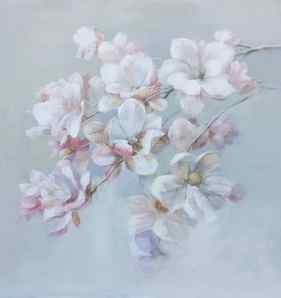Why Is It So Hard to Paint Lightning?
by Jessica Leigh Hester June 8, 2018

William Nicholson Jennings, of Philadelphia, spent most of his days photographing wrecked or damaged infrastructure for the Pennsylvania Railroad. When it got dark and stormy, though, he pointed his camera up and tried to record bolts of lightning as they crackled across the sky.
What the 19th-century commercial photographer saw up there didn’t look like what he remembered from paintings or stage sets, where lightning was usually depicted as a series of a few sharp, jagged spears. Up there, on the bigger canvas of the sky, Jennings saw something much more complicated, and he wanted to capture it.
More than a century after Jennings raised questions about the fidelity of artistic depictions of lightning, a team of researchers from the Environmental Optics Laboratory at Eötvös Loránd University in Budapest set out to answer it.

The researchers used software to compare 400 photographs of lightning storms to 100 paintings with lightning in them, made between 1500 and 2015. They found some consistent differences, which they describe in a new paper in the Proceedings of the Royal Society A. Compared to real bolts, painted lightning tends to have fewer branches—no more than 11, the authors found, while the photographs depict as many as 51.
To venture a guess about why these differences might have emerged, the researchers also brought some humans into the lab and flashed images of lightning in front of them for a second or less. The subjects had to guess how many branches the lightning had, and the researchers found that they were only able to reliably do so when there were no more than 11 branches. It seems painters were representing what they had the capacity to perceive with the naked eye.

It is easy to paint lightning, it is just hard to paint it right. Photographing it would provide an accurate representation, but it was difficult to do—especially in the days of bulky cameras and long, long exposures. Jennings was determined to do it. He clambered up to his roof whenever a storm blew in, and in 1882, he finally got it: a photograph of lightning tracing a ragged path across the sky, branching like a root system. (In an even earlier daguerrotype, taken by Thomas Martin Easterly in St. Louis in 1847, the bolt looks like a river winding across a map.) Jennings’s work was later published in Scientific American and in the U.S. Weather Bureau’s monthly bulletin. And in the years since—and especially since 2000, the Eötvös Loránd team found—artists have been depicting lightning with more faithfulness to the real, wondrous thing. Because, it stands to reason, they’d seen it frozen in a photograph.
The art of portraying lightning on canvas
from OWLS Quarterly, Eighth Edition
Olivia Jin (OHS)
The tree has been a common source of inspiration for most artists since the emergence of art itself, one that is visibly ingrained into our landscape due to their widespread distribution. Most paintings, across all styles, are likely to include a tree, and most artists have spent time studying how to reproduce a tree on paper. We have long perceived trees as symbols of life, regrowth and strength due to their seasonal death and re-emergence. A more conventional reason for influence of trees in art is because of their abundance – they are crucial for any art involving landscape and nature, and their complex appearance, difficult to transpose onto canvas, gives an opportunity to hone manual and observational skills. It could be seen that the history of the close relation between people, trees and art mostly arises from a deep emotional appreciation we have for trees, and their unexplained special meaning to us. Historically, trees have been harnessed as symbols since antiquity. The cyclic nature of a tree’s seasonal death and regrowth have presented them as symbols of resurrection; a common motif within many cultures’ mythology usually involves a ‘tree of life,’ or ‘world tree’ connecting the human world with the supernatural. This concept has contributed to the foundation for mythology and religion to emerge across civilisations, consequently, trees have become a focal point of religious and visual art. Famous paintings depicting a ‘tree of life’ include Gustav Klimt’s The Tree of Life, painted in 1905. The symbolic painting represents the relationship between heaven, earth and the underworld, with swirling branches tangled amongst one another expressing the complexity of life. own language through tree symbolism: in the West, Olive trees are labelled by Christians as a symbol of peace, while Cypress trees have been coined as symbols of death long before Christianity. The Palm is closely associated with salvation and Paradise and is typically painted into biblical scenes of the Entry into Jerusalem, such as this fresco painted by the renaissance artist Giotto.

Entry into Jerusalem, Giotto (1305) There is a link between how trees are used as symbols of characteristics or values and their emotional presence within a piece of artwork – in particular, trees have a certain atmospheric quality that is explored through art. Significantly, Romantic art uses trees and nature for emotive purpose. The artist, Maxim Vorobiev, painted Oak Fractured by Lightning after the death of his wife. The imagery of the Oak being struck by lightning clearly symbolises the pain he felt upon his wife’s death.
Maxim Vorobiev, Oak Fractured by Lightning (1842) While Romantic art was meant to capture emotive scenery in a dramatized light, traditional Japanese art promotes peace, harmony and spirituality; infamously, Japanese culture has always been closely linked to nature. The focus on nature in ancient paintings capture the traditional aesthetics of Japanese culture, reflecting the values shared by artists during the period. When Hasegawa Tohaku painted his Pine Trees, Japan was experiencing an artistic movement emphasising traditional simplicity and minimalism.
Gustav Klimt, The Tree of Life (1905) Myth and legend are closely linked to trees – sacred trees have an importance presence in many ancient myths, the subject of most ancient religious art and subsequent art periods such as renaissance and neoclassical art. It seems religion has created its very

Hasegawa Tohaku, Pine Trees left screen (1595) A famous example of an artist with a close relation to nature include the works of impressionist painter Van Gogh. He painted his Olive Trees series at the height of his illness, to find mental and emotional relief through reconnecting with nature. Van Gogh believed the growth cycle of an olive tree embodied the cycle of human life. Despite being generally dismissive of religion, Van Gogh found great meaning and spirituality while immersed in nature. Van Gogh’s later works demonstrate how a close spiritual link with nature can impact the emotions of an artist.
Vincent Van Gogh, Landscape with Olive Trees (1889) The important cultural values we ascribe to different tree species across the world has inextricably been expressed through the art we create. This is still evident today, especially regarding environmental issues such as deforestation. Art is a common medium used for activism and the growing environmental movement has inspired a huge quantity of art, demonstrating how trees have also been used in art for political purposes. As art continues to evolve, one of the key influences on art of future generations may be the changing environment, and the greater prevalence of the preservation of trees and the natural world. Bibliography



